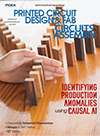News
News
Reflow Soldering with a SnCu Eutectic Pb-Free Alloy
Published: 03 September 2008
by Gerjan Diepstraten
The performance matches SAC, but with shinier joints.

SnCuNi is an established no-silver Pb-free alloy for wave soldering applications. The alloy is beginning to be applied to reflow applications. This alloy is more popular in wave soldering for numerous reasons, including lower cost (no silver), minor copper leaching and reduced dross formation.
SnCuNi alloys were not of interest for reflow soldering when Pb-free was introduced because of their high melting temperature (227ºC). Since then, process engineers have learned melting point is not the sole factor in Pb-free reflow soldering. There are other issues:
- Copper leaching is a critical issue with SAC 305. After multiple soldering processes, the copper pad may have disappeared when it comes time to rework.
- Reliability of SAC 305 is acceptable for component leads; it can accommodate strain – e.g., from SOICs and QFPs – but for leadless components, where the solder has to absorb all the strain (BGAs, LCCCs), SnCuNi is more reliable.1
- SnCuNi shows less voiding in the majority of applications thus far.
- SAC 305 joints are dull and grainy, with the surface showing a microstructure of coarse intermetallic crystals. While simple SnCu eutectic exhibits a dull cracked surface when cooled slowly, SnCu with the nickel addition solidifies with a generally smooth bright finish under the same conditions.2
Reflow on Copper OSP
The goal of this design of experiment is to identify differences in soldering between SAC alloys and SnCuNi. Solder paste was printed on a Cu-plated board with an Ethone Entek Plus (Cu-106HT) passivation on it.
Three different SAC alloys were compared with SnCuNi. One of the SAC 305 alloys (A) has the same flux chemistry as the SnCuNi (D) (Figure 1).

Other parameters in the experiment were the reflow profile (3 min. linear versus a 5 min. ramp soak spike) and number of heating cycles (Table 1). In one case, the board was reflowed before the paste was printed and heated for a second cycle.

After reflow, the solder spreading and intermetallic layers were measured to see how the different pastes performed under the varying conditions.
Solder spreading. It is commonly known that SAC 305 doesn’t spread on Cu OSP surfaces as easily as does SnPb. Spreading was measured using a microscope. Solder paste is the parameter that most affects spreading, even more so than the solder paste chemistry. For both alloys, the chemistry used for sample A and D is performing best (Figures 2 and 3).


Intermetallic growth. The second part of the experiment defined the impact on the intermetallic growth of the different parameters (Figure 4). The conclusions are:
- No significant difference is seen between the 3 min. linear and 5 min. ramp-soak spike heating profile.
- One heating cycle before reflow soldering resulted in a slightly thinner intermetallic layer (5% on average). This may be caused by more oxidation of the copper surface.
- The average IMC thickness of SnCuNi is more or less equal to that of SAC 305, although time above liquidus and superheat are less.

Conclusions
The experiment found:
- No significant differences between SnCuNi and SAC alloy when reflowed under the same conditions. However, the SnCuNi solder is shinier, much like SnPb.
- A minimum peak temperature of 240ºC is required for SnCuNi to achieve good solder coalescence.
- Although time above liquidus is less for SnCuNi (higher melting point), the initial intermetallic thickness is not different from that of SAC alloy. Previous investigations showed that on account of nickel, the intermetallic does not increase as much as that of the SAC alloy after aging.
References
- Thomas Kolossa, Balver Zinn presentation on SN100C reliability.
- Frédéric Martinez, Syed Asif Arnaud, Keith Sweatman and Tetsuro Nishimura, “Improving the Performance of the Tin-Copper Eutectic as a Pb-free Solder.”
Gerjan Diepstraten is process support manager at Cobar Europe BV (cobar.com); g.diepstraten@cobar.com
Press Releases
- NEPCON ASIA 2025: Innovating Smart Manufacturing Ecosystems and Bridging Global Opportunities
- Viasion Technology Expands Global Reach as a Trusted PCB Manufacturer and EMS Provider in China
- Viasion Technology Expands Global Reach as a Trusted PCB Manufacturer and EMS Provider in China
- Nordson Test & Inspection Expands Partnership with Distributor smartTec Nordic A/S







